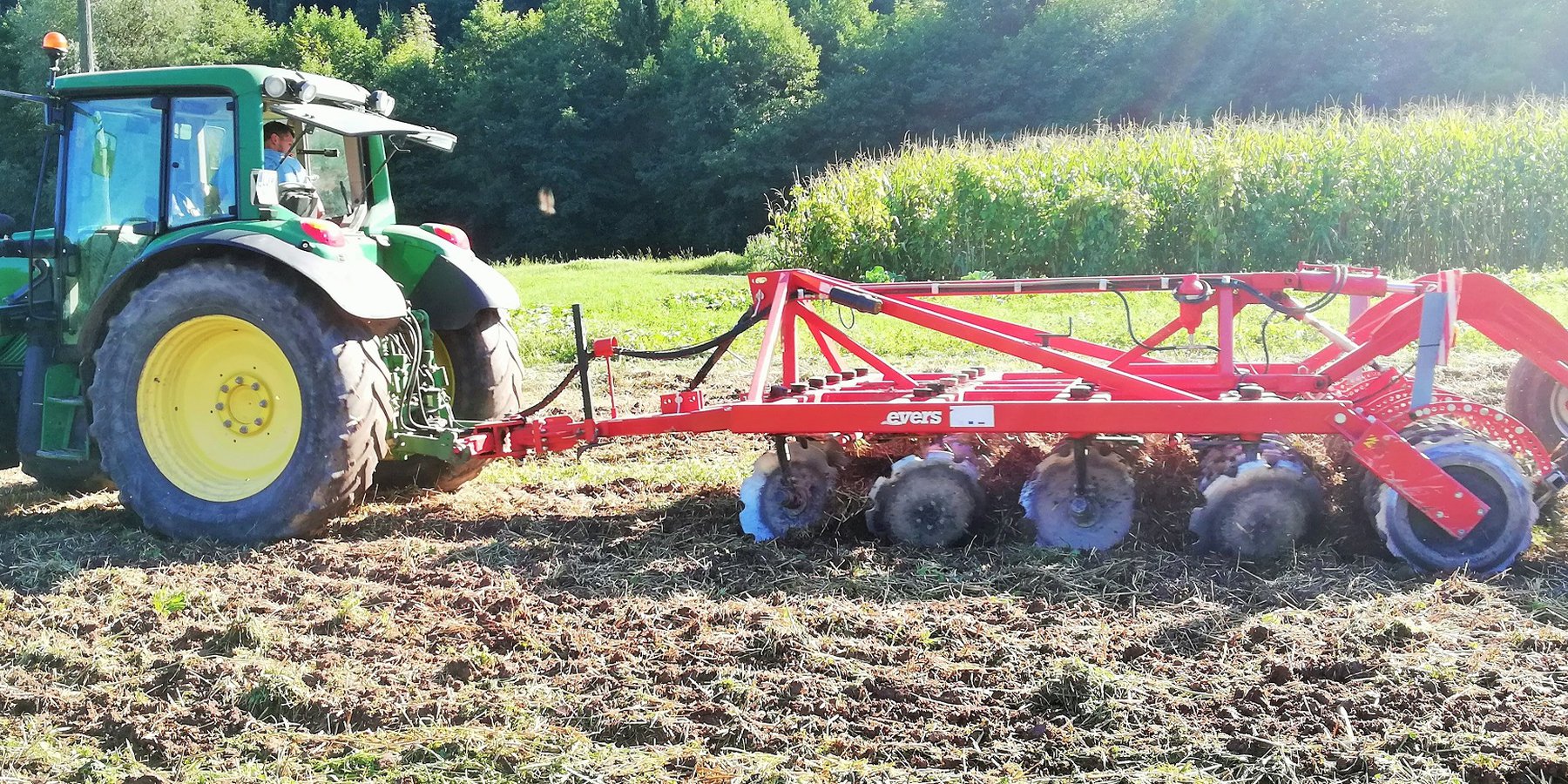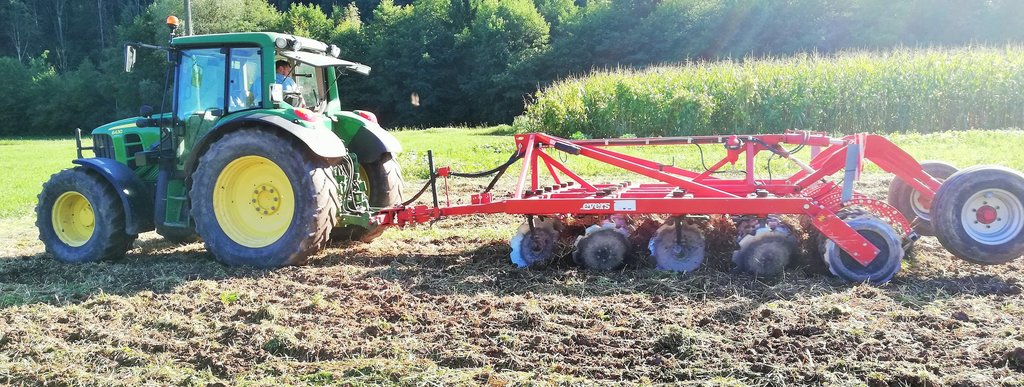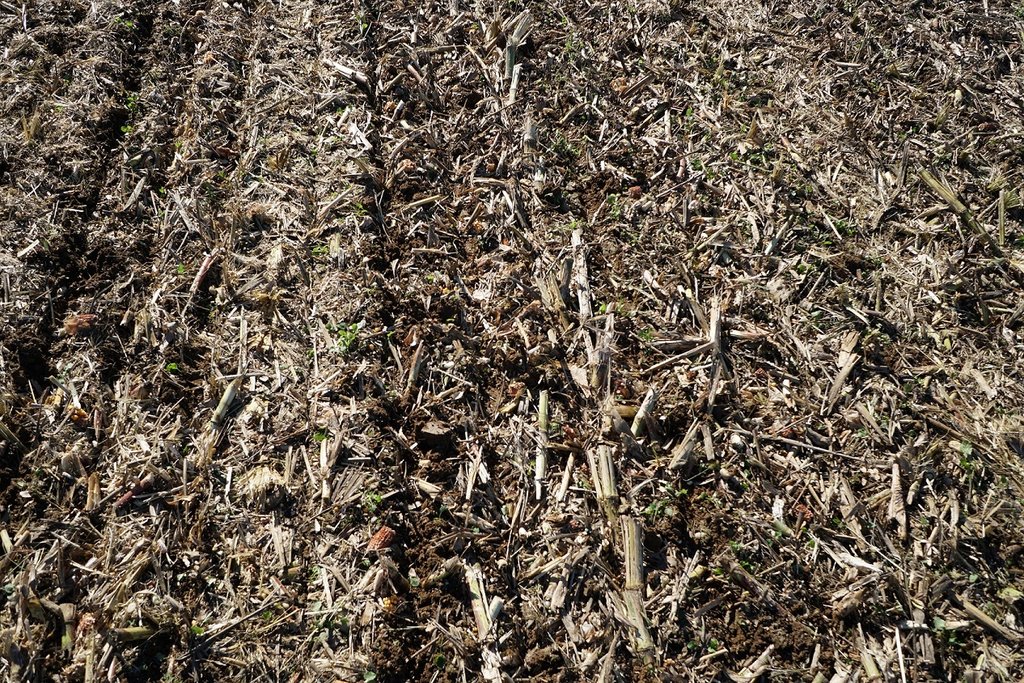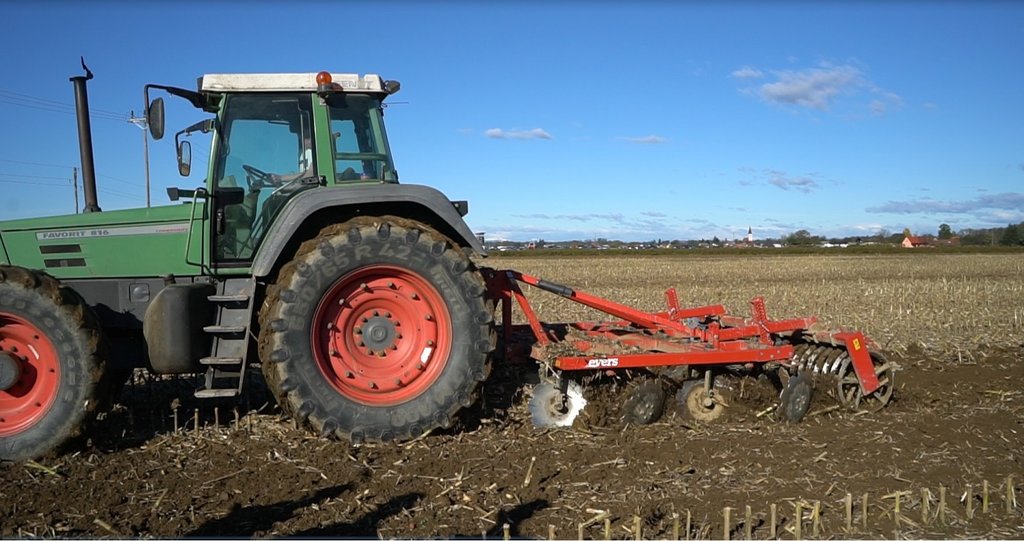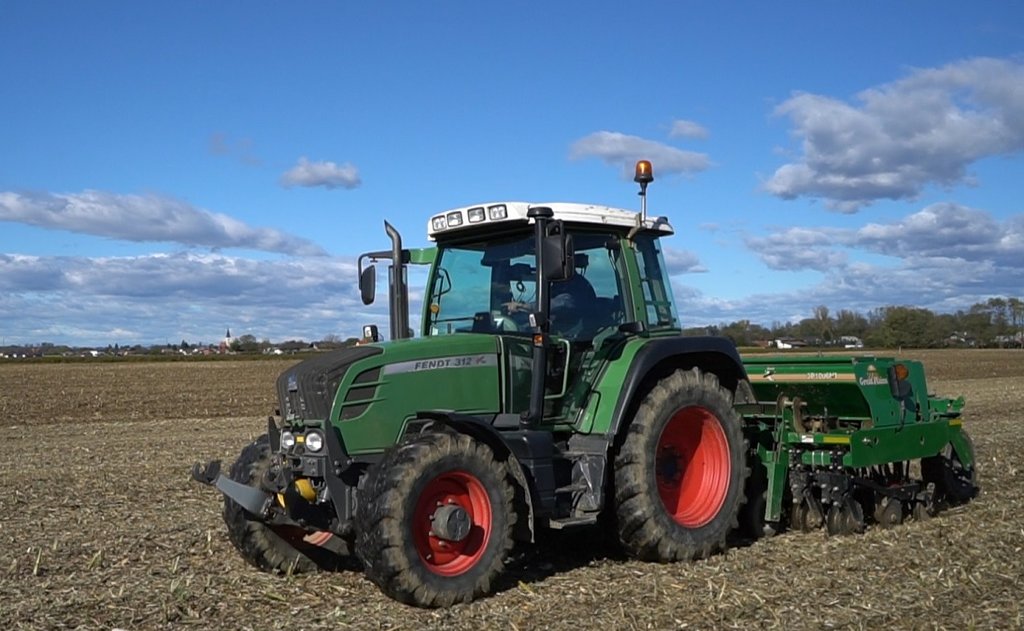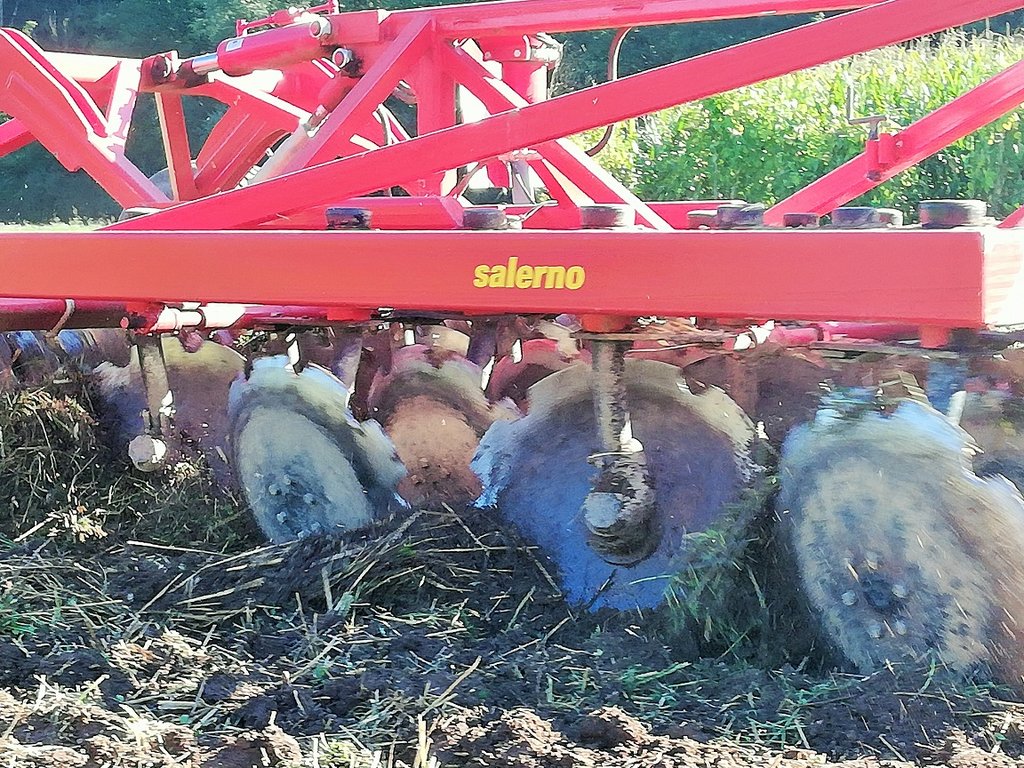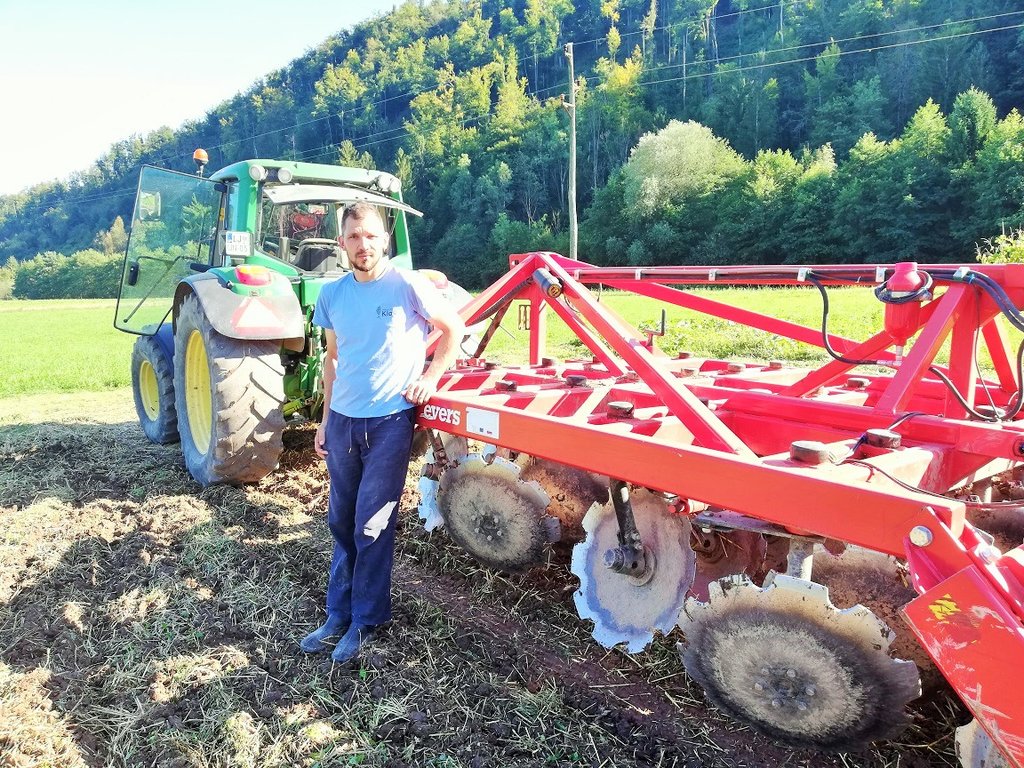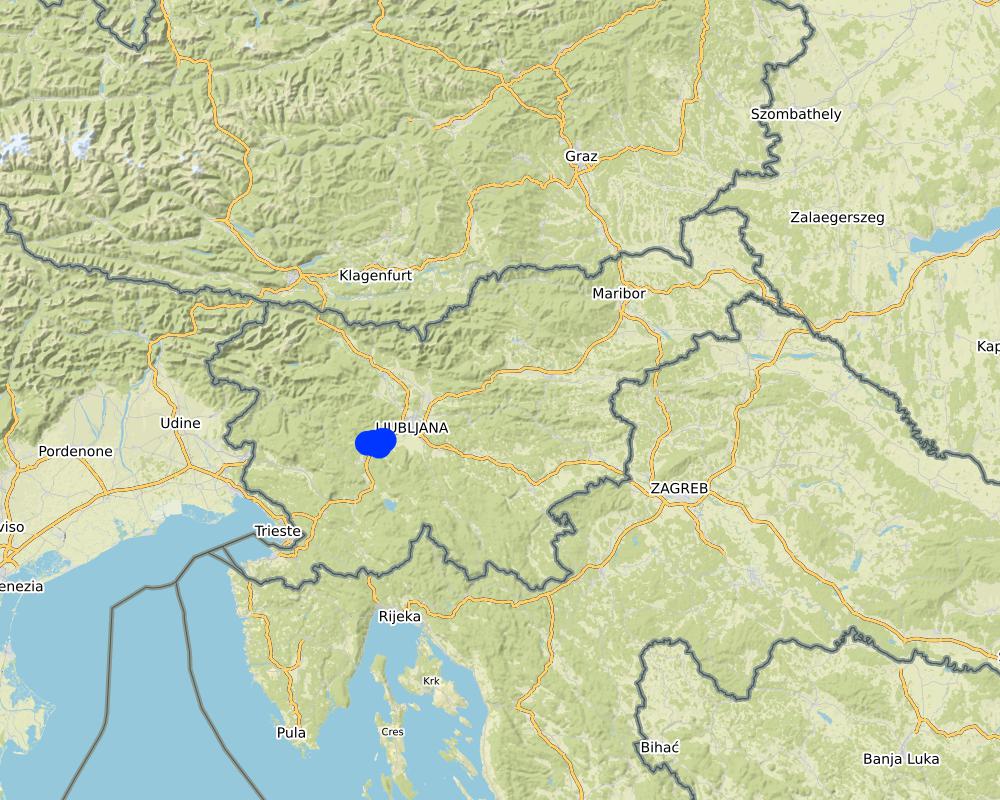Conservation tillage with incorporated mulched plant residues (mulch-till) [สโลวีเนีย]
- ผู้สร้างสรรค์:
- การอัพเดท:
- ผู้รวบรวม: Matjaz Glavan
- ผู้เรียบเรียง: –
- ผู้ตรวจสอบ: Rima Mekdaschi Studer
Ohranitvena obdelava tal z vdelavo mulčenih rastlinskih ostankov
technologies_5494 - สโลวีเนีย
ดูส่วนย่อย
ขยายทั้งหมด ย่อทั้งหมด1. ข้อมูลทั่วไป
1.2 รายละเอียดที่ติดต่อได้ของผู้รวบรวมและองค์กรที่เกี่ยวข้องในการประเมินและการจัดเตรียมทำเอกสารของเทคโนโลยี
วิทยากรหลัก
ผู้ใช้ที่ดิน:
Mrzlikar Anton
Family farm
สโลวีเนีย
ชื่อของโครงการซึ่งอำนวยความสะดวกในการทำเอกสารหรือการประเมินเทคโนโลยี (ถ้าเกี่ยวข้อง)
Interactive Soil Quality assessment in Europe and China for Agricultural productivity and Environmental Resilience (EU-iSQAPER)ชื่อขององค์กรซึ่งอำนวยความสะดวกในการทำเอกสารหรือการประเมินเทคโนโลยี (ถ้าเกี่ยวข้อง)
Department for Agronomy, University of Ljubljana - สโลวีเนีย1.3 เงื่อนไขการใช้ข้อมูลที่ได้บันทึกผ่านทาง WOCAT
ผู้รวบรวมและวิทยากรหลักยอมรับเงื่อนไขเกี่ยวกับการใช้ข้อมูลที่ถูกบันทึกผ่านทาง WOCAT:
ใช่
1.4 การเปิดเผยเรื่องความยั่งยืนของเทคโนโลยีที่ได้อธิบายไว้
เทคโนโลยีที่ได้อธิบายไว้นี้เป็นปัญหาของความเสื่อมโทรมโทรมของที่ดินหรือไม่ จึงไม่ได้รับการยอมรับว่าเป็นเทคโนโลยีเพื่อการจัดการที่ดินอย่างยั่งยืน:
ไม่ใช่
2. การอธิบายลักษณะของเทคโนโลยี SLM
2.1 การอธิบายแบบสั้น ๆ ของเทคโนโลยี
คำจำกัดความของเทคโนโลยี:
Conservation tillage with incorporated mulched plant residues (mulch-till) of harvested crop or a green manure that are part of the rotation). Crop residues are partially incorporated/mixed in topsoil layer (down to 10 cm) using a disc harrow, chisel plough, sweeps, field cultivators, that leave more than 30% of the soil surface covered with crop residue. Technology contributes to less soil disturbance, increase of soil organic matter, better soil structure and better water holding capacity of soils.
2.2 การอธิบายแบบละเอียดของเทคโนโลยี
คำอธิบาย:
1. The technology of conservational tillage with incorporated mulched plant residues (mulch-till) is applied in flatlands around the Municipality of Vrhnika with an average altitude of 290 m.a.s.l. Average annual precipitation is 1400 mm. The area is characterized with often stormy precipitation events and occasional summer droughts. A farmer applies this technology on various soil types from silty loam to silty clay Gleysol to organic Histosol soils (peat). Soils in the area are generally moderately deep to deep with medium soil organic matter (Gleysol) of 3-7% or with a high share of organic matter (Histosol) of >20% (Ljubljana moors). The area has good availability of surface water and groundwater of good drinking quality. Gleysol areas are drained (drainage systems) to prevent floods to enable cultivation. Histosol areas are drained (open-channel drainage systems) to enable arable crop production. However, due to high groundwater and many surface water sources, certain areas are regularly flooded during flood events mostly in late autumn, winter and spring. Salinity is not a problem due to high precipitation and leaching. Farmer practices rotational agriculture. Less than 5% of income coming from off-farm activities. The examined farm household has an average wealth and is fully mechanized/motorized. the farm has good access to services and infrastructure. The examined farm is medium in scale with land partly owned by the land user and partly leased from other private owners.The general biodiversity of the area is medium on Gleysols to high on Histosol where nature protection Landscape Park of Ljubljansko Barje (The Ljubljana Moors Landscape Park) is located.
Part of the farmers land parcels is located inside boundaries of Krajinski park Ljubljansko barje /Ljubljana Moor Landscape park. Park takes a lot of actions to secure peat soils. This almost 16,000 hectares large lowland marshy plain is marked by an interminable mosaic of grasslands, broadleaf woodlands, fields, ditches and hedges.
The farmer decided to abandon conventional ploughing technology and to start with conservational tillage technology when he noticed that the organic layer of peat soils in these areas started to become thinner. Farmer introduced this technology to preserve peat soils of Ljubljana Moors on his parcels in 2015. With ploughing, peat was mixed and decomposing - mineralise. In 18th-century peat layers of up to 2m depth were exploited for the same use as firewood. Only shallow layers of peat soil (up to 1 m) are still covering agricultural areas. As peat is a source of fertility farmers are seeking ways of preserving it. Farmer Anton Mrzlikar took a lead and started with conservational tillage with incorporated mulched plant residues (mulch-till).
Video https://vimeo.com/97415985 presents the effects of conservational tillage with incorporated mulched plant residues (mulch-till) on soil stability. This is a simulation of abundant summer rain and its impact on the tilled soils in terms of water infiltration capacity and erodibility. The result of this simulation is presented very clearly. It shows the difference between long-term conventional versus conservation tillage (mulch-till). Conventional tillage ploughs the top 25-28 cm of the soil at least once or twice a year. The soil is inverted, its structure breaks down and the surface is left bare. The first raindrops break the structural aggregates causing soil surface siltation and blockage of the soil pores. Thus vertical water flow is blocked and redirected as surface runoff, causing distinct erosion. If fertilizers and pesticides are used, the water flow will transport them, along with the soil particles, to surface waters where they cause pollution or surface ponding on the fields. This leads to an uneven distribution of substances across the field surface.
In conservation tillage (mulch-till), a shallow, 10 cm layer of topsoil is mixed with organic residues which are thus retained near and on the surface. In this way, soil structure is reinforced with good soil water infiltration and absorption. Despite heavy rainfall, the soils do not show any signs of erosion. There is no surface flow. Water drains into the soil vertical flow where it is available to the plants.
2. The farmer usees of 4-row-disk harrow tillage machinery (vario-disc) on arable fields for all crop types. When cultivating fields he crosses fields 1 - 2 times (depends on soil moisture). Every few years he uses chisels to break and shatters (aerate) the soils (depends on crop type - cereals and drought years). After main/first crop he seeds various cover crops (if fodder is needed they harvested it otherwise is used for green manure). He uses manure 30-40 t/ha. He applies typical dairy cow farm rotation (cereals/maize/soya/grass-clover mix). Cover crops are classified as rapes, cereals, oats, grass-clover, grass.
3. The main function is an increase of organic matter, retain water, increase soil biodiversity, stabilise soil structure in the soils and reduce water erosion, as well as reduce energy consumption and costs. This leads to better (1) productivity due to nutrients slow-release, (2) better water holding capacity and (3) decreased soil compaction threat. The technology was introduced to prevent decomposition of organic matter on Ljubljana moor peat soils.
4. Major inputs needed to establish is to change machinery and to gain new knowledge and experiences. They had to buy 4-row disc harrows, chisels plough and new seeders (maize). Seeding machines for cereals and oilseed rape are hired from other farmers. It is important that soils are covered all year round. Soils must be dry when cultivated.
5. The benefits are (1) increase in soil organic matter, (2) increase soil water holding capacity, (3) to maintain soil productivity, (4) increase in yields quantity and quality, (5) reduce energy consumption, (6) reduce workload - 3-4 times less time used for cultivation, (7) reduce costs.
6. Land users like (1) reduced workload and energy consumption, (2) positive impact on soil fertility and stability, (3) preserves organic matter - decrease peat soils decomposition, (4) as soils need to be covered all the time they produce more feed for cows, (5) smooths surface fields, (6) with disc harrow is easy to till soils even when residues are present on fields, (7) less soil compaction
Land users dislike: (1) investment cost for new machinery are high, (2) time to change in doing things and practice, (3) on clay soils (Gleysol) surface ponding is occurring, (4) soils need to be drier for tilling in comparison to ploughing.
2.3 รูปภาพของเทคโนโลยี
2.4 วีดีโอของเทคโนโลยี
ความคิดเห็น/อธิบายสั้นๆ:
This is a simulation of abundant summer rain and its impact on the tilled soils in terms of water infiltration capacity and erodibility. The result of this simulation is presented very clearly. It shows the difference between long-term conventional versus conservation soil tillage.
Conventional tillage ploughs the top 25-28 cm of the soil at least once or twice a year. The soil is inverted, its structure breaks down and the surface is left bare. The first raindrops break the structural aggregates causing soil surface siltation and blockage of the soil pores. Thus vertical water flow is blocked and redirected as surface runoff, causing distinct erosion. If fertilizers and pesticides are used, the water flow will transport them, along with the soil particles, to surface waters where they cause pollution or surface ponding on the fields. This leads to an uneven distribution of substances across the field surface.
In conservation tillage (mulch-till), a shallow, 10 cm layer of topsoil is mixed with organic residues which are thus retained near and on the surface. In this way, soil structure is reinforced with good soil water infiltration and absorption. Despite heavy rainfall, the soils do not show any signs of erosion. There is no surface flow. Water drains into the soil vertical flow where it is available to the plants.
วันที่:
04/12/2017
สถานที่:
Ljubljana, Biotechnical Faculty, University of LJubljana
ชื่อผู้ถ่ายวีดีโอ:
Rok Mihelič, Marko Zupan, Matjaž Glavan - Agronomy Department, Biotechnical Faculty, University of Ljubljana
ความคิดเห็น/อธิบายสั้นๆ:
Presenting 4-row disch harrow in action.
วันที่:
12/04/2017
สถานที่:
Slovenia
ชื่อผู้ถ่ายวีดีโอ:
Rok Mihelič, Agronomy Department, Biotechnical Faculty, University of Ljubljana
ความคิดเห็น/อธิบายสั้นๆ:
Presening seeder (cereals/oilseed rape) in action and condition of soil surface after tillage and seeding.
วันที่:
12/04/2017
สถานที่:
Slovenia
ชื่อผู้ถ่ายวีดีโอ:
Rok Mihelič, Agronomy Department, Biotechnical Faculty, University of Ljubljana
2.5 ประเทศภูมิภาค หรือสถานที่ตั้งที่เทคโนโลยีได้นำไปใช้และได้รับการครอบคลุมโดยการประเมินนี้
ประเทศ:
สโลวีเนีย
ภูมิภาค/รัฐ/จังหวัด:
Central Slovenia
ข้อมูลจำเพาะเพิ่มเติมของสถานที่ตั้ง :
Podlipa, Vrhnika. This specific farmer applies this technology on Ljubljansko barje, othewise is applied all over Slovenia
ระบุการกระจายตัวของเทคโนโลยี:
- ใช้ ณ จุดที่เฉพาะเจาะจงหรือเน้นไปยังบริเวณพื้นที่ขนาดเล็ก
Is/are the technology site(s) located in a permanently protected area?
ใช่
ถ้าใช่ ระบุ:
Part of his land parcels is located inside boundaries of Krajinski park Ljubljansko barje /Ljubljana Moor Landscape park. Park takes a lot of actions to secure peat soils. This almost 16,000 hectares large marshy plain is marked by an interminable mosaic of grasslands, broadleaf woodlands, fields, ditches and hedges.
http://www.ljubljanskobarje.si/?lang=en
Map
×2.6 วันที่การดำเนินการ
ระบุปีที่ใช้:
2015
ถ้าไม่รู้ปีที่แน่นอน ให้ระบุวันที่โดยประมาณ:
- น้อยกว่า 10 ปี (ไม่นานนี้)
2.7 คำแนะนำของเทคโนโลยี
ให้ระบุว่าเทคโนโลยีถูกแนะนำเข้ามาอย่างไร:
- ด้วยการริเริ่มของผู้ใช้ที่ดินเอง
ความคิดเห็น (ประเภทของโครงการ เป็นต้น) :
Farmer introduced this technology to preserve peat soils of Ljubljana Moors on his parcels in 2015. With ploughing, peat was mixed and decomposing - mineralise. In 18th-century peat layers of up to 2m depth were exploited for the same use as firewood. Only shallow layers of peat soil (up to 1 m) are still covering agricultural areas. As peat is a source of fertility farmers are seeking ways of preserving it. Farmer Anton Mrzlikar took a lead and started with mulch-till.
3. การจัดประเภทของเทคโนโลยี SLM
3.1 วัตถุประสงค์หลักของเทคโนโลยี
- ลด ป้องกัน ฟื้นฟู การเสื่อมโทรมของที่ดิน
- ปรับตัวเข้ากับการเปลี่ยนแปลงภูมิอากาศของโลก สภาพภูมิอากาศที่รุนแรงและผลกระทบ
- สร้างผลกระทบทางด้านเศรษฐกิจที่เป็นประโยชน์
3.2 ประเภทของการใช้ที่ดินในปัจจุบันที่ได้นำเทคโนโลยีไปใช้
Land use mixed within the same land unit:
ไม่ใช่

พื้นที่ปลูกพืช
- การปลูกพืชล้มลุกอายุปีเดียว
Annual cropping - Specify crops:
- cereals - maize
- cereals - maize - legumes - grass-clover mix
Annual cropping system:
Maize or similar rotation with hay/pasture
จำนวนของฤดูเพาะปลูกต่อปี:
- 1
Is intercropping practiced?
ไม่ใช่
Is crop rotation practiced?
ใช่
ถ้าใช่ ระบุ:
cereals/maize/soy/grass-clover mix, additionally cover crops after main crop (soil must be covered all year round
3.3 Has land use changed due to the implementation of the Technology?
Has land use changed due to the implementation of the Technology?
- No (Continue with question 3.4)
3.4 การใช้น้ำ
การใช้น้ำของที่ดินที่มีการใช้เทคโนโลยีอยู่:
- จากน้ำฝน
3.5 กลุ่ม SLM ที่ตรงกับเทคโนโลยีนี้
- การรบกวนดินให้น้อยที่สุด
3.6 มาตรการ SLM ที่ประกอบกันเป็นเทคโนโลยี

มาตรการจัดการพืช
- A2: อินทรียวัตถุในดิน/ความอุดมสมบูรณ์ในดิน
- A3: การรักษาหน้าดิน
A3: Differentiate tillage systems:
A 3.2: Reduced tillage (> 30% soil cover)
3.7 รูปแบบหลักของการเสื่อมโทรมของที่ดินที่ได้รับการแก้ไขโดยเทคโนโลยี

การกัดกร่อนของดินโดยน้ำ
- Wt (Loss of topsoil): การสูญเสียดินชั้นบนหรือการกัดกร่อนที่ผิวดิน

การเสื่อมโทรมของดินทางด้านกายภาพ
- Pc (Compaction): การอัดแน่น
- Ps (Subsidence of organic soils): การยุบตัวของดินอินทรีย์ การทรุดตัวของดิน
3.8 การป้องกัน การลดลง หรือการฟื้นฟูความเสื่อมโทรมของที่ดิน
ระบุเป้าหมายของเทคโนโลยีกับความเสื่อมโทรมของที่ดิน:
- ลดความเสื่อมโทรมของดิน
แสดงความคิดเห็น:
It is impossible to prevent degradation in the form of peat soil mineralisation in agricultural soils.
4. ข้อมูลจำเพาะด้านเทคนิค กิจกรรมการนำไปปฏิบัติใช้ ปัจจัยนำเข้า และค่าใช้จ่าย
4.1 แบบแปลนทางเทคนิคของเทคโนโลยี
4.2 ข้อมูลทั่วไปเกี่ยวกับการคำนวณปัจจัยนำเข้าและค่าใช้จ่าย
ให้ระบุว่าค่าใช้จ่ายและปัจจัยนำเข้าได้รับการคำนวณอย่างไร:
- ต่อพื้นที่ที่ใช้เทคโนโลยี
ระบุขนาดและหน่วยพื้นที่:
30 ha
อื่นๆ หรือสกุลเงินประจำชาติ (ระบุ):
EUR
If relevant, indicate exchange rate from USD to local currency (e.g. 1 USD = 79.9 Brazilian Real): 1 USD =:
0.9
ระบุค่าเฉลี่ยของค่าจ้างในการจ้างแรงงานต่อวัน:
50 EUR
4.3 กิจกรรมเพื่อการจัดตั้ง
| กิจกรรม | Timing (season) | |
|---|---|---|
| 1. | Preparation of fields: Leveling depressions, reconstruction of drainage channels, using chisels to loose, break and aerate soil in deeper layers | two year before implemenation, dry soil. |
| 2. | Purchase of 4-row disc harrow | 1st year |
| 3. | Purchase of seeder for maize | 1st year |
| 4. | Purchase of seeder for cover crops | 1st year |
| 5. | Hire seeder for cereals (wheat, barley) | 1st year |
| 6. | Home made chisel plow for loosening the soil | 2nd year |
| 7. | Purchase of spraying machine | 3rd year |
| 8. | Purchase of GPS navigation system | 3rd year |
แสดงความคิดเห็น:
The agricultural technology activities are listed in chronological order. Rotation cycle takes 3 years
4.4 ค่าใช้จ่ายของปัจจัยนำเข้าที่จำเป็นสำหรับการจัดตั้ง
| ปัจจัยนำเข้า | หน่วย | ปริมาณ | ค่าใช้จ่ายต่อหน่วย | ค่าใช้จ่ายทั้งหมดต่อปัจจัยนำเข้า | %ของค่าใช้จ่ายที่ก่อให้เกิดขึ้นโดยผู้ใช้ที่ดิน | |
|---|---|---|---|---|---|---|
| อุปกรณ์ | chisel plow material (home made) | EUR/piece | 1.0 | 6500.0 | 6500.0 | 100.0 |
| อุปกรณ์ | seeder fo cover crops | EUR/piece | 1.0 | 2500.0 | 2500.0 | 50.0 |
| อุปกรณ์ | seeder for maize | EUR/piece | 1.0 | 7500.0 | 7500.0 | 50.0 |
| อุปกรณ์ | 4-row disk harrow | EUR/piece | 1.0 | 23000.0 | 23000.0 | 50.0 |
| อุปกรณ์ | sprayer | EUR/piece | 1.0 | 12.5 | 12.5 | 25.0 |
| อุปกรณ์ | GPS navigation | EUR/piece | 1.0 | 2500.0 | 2500.0 | 100.0 |
| อุปกรณ์ | hire seeder for cereals | EUR/ha | 15.0 | 50.0 | 750.0 | 100.0 |
| ค่าใช้จ่ายทั้งหมดของการจัดตั้งเทคโนโลยี | 42762.5 | |||||
| Total costs for establishment of the Technology in USD | 47513.89 | |||||
ถ้าผู้ใช้ที่ดินรับภาระน้อยกว่า 100% ของค่าใช้จ่าย ให้ระบุว่าใครเป็นผู้รับผิดชอบส่วนที่เหลือ:
50% - Agency for agricultural payments (EU funds); 25% - sharred among farmers
แสดงความคิดเห็น:
Cost for hiring seeder is calculated for 15ha as cereals cover 15ha of arable land.
4.5 การบำรุงรักษาสภาพหรือกิจกรรมที่เกิดขึ้นเป็นประจำ
| กิจกรรม | ช่วงระยะเวลา/ความถี่ | |
|---|---|---|
| 1. | Maintenance of 4-disc harrow | 6 time per year, before or after use of equipment |
| 2. | Maintenance of Spayer | before use nozzels check, after use cleaning |
| 3. | Maintenance of seeder for maize | before and after use |
| 4. | Maintenance of seeder for cover crops | before and after use |
4.6 ค่าใช้จ่ายของปัจจัยนำเข้าและกิจกรรมที่เกิดขึ้นเป็นประจำที่ต้องการการบำรุงรักษา (ต่อปี)
| ปัจจัยนำเข้า | หน่วย | ปริมาณ | ค่าใช้จ่ายต่อหน่วย | ค่าใช้จ่ายทั้งหมดต่อปัจจัยนำเข้า | %ของค่าใช้จ่ายที่ก่อให้เกิดขึ้นโดยผู้ใช้ที่ดิน | |
|---|---|---|---|---|---|---|
| แรงงาน | Maintenance of 4-disc harrow | hour | 6.0 | 6.25 | 37.5 | 100.0 |
| แรงงาน | Maintenance of Spayer | hour | 6.0 | 6.25 | 37.5 | 100.0 |
| แรงงาน | Maintenance of seeder for maize | hour | 4.0 | 6.25 | 25.0 | 100.0 |
| แรงงาน | Maintenance of seeder for cover crops | hour | 1.0 | 6.25 | 6.25 | 100.0 |
| อุปกรณ์ | Lubricant cartridge for4-disc harrow | cartridge | 18.0 | 5.0 | 90.0 | 100.0 |
| อุปกรณ์ | Nozzels for Spayer | nozzel | 20.0 | 4.0 | 80.0 | 100.0 |
| อุปกรณ์ | Lubricant cartridge for seeder for maize | cartridge | 4.0 | 5.0 | 20.0 | 100.0 |
| อุปกรณ์ | Lubricant cartridge for seeder for cover crops | cartridge | 1.0 | 5.0 | 5.0 | 100.0 |
| ค่าใช้จ่ายทั้งหมดของการบำรุงรักษาสภาพเทคโนโลยี | 301.25 | |||||
| Total costs for maintenance of the Technology in USD | 334.72 | |||||
แสดงความคิดเห็น:
There is a big difference between conventional and conservation tillage in time spend cultivating fields.
Farmer estimates reduction in workload (no ploughing) for 3-4 times in comparison to the conventional ploughing system.
Farmer points out an increase in green mass yield (clover, grass) due to cover crops which can be used as feed for livestock or green manure. He said that the most important part of this conservational system (mulch-till) is to prevent weeds to germinate, and that's why soil needs to be covered at all times.
He also states that top and subsoil layers are loose.
He states that he still uses the same amount of plant protection products.
The use of herbicides and fertilisers is at the same range as before the shift in practice, but he expects improvements in the future when he will further enhance knowledge on crop types, rotation and cover crops.
4.7 ปัจจัยสำคัญที่สุดที่มีผลกระทบต่อค่าใช้จ่าย
ปัจจัยสำคัญที่สุดที่มีผลกระทบต่อค่าใช้จ่ายต่างๆ:
The starting cost - The type of machinery is needed that has to be robust and heavy to much-till and seed into the soil.
The machinery must be in use to return a profit. Working hours are reduced now (no ploughing). Machine operators with more competences can reduce costs.
5. สิ่งแวดล้อมทางธรรมชาติและของมนุษย์
5.1 ภูมิอากาศ
ฝนประจำปี
- < 250 ม.ม.
- 251-500 ม.ม.
- 501-750 ม.ม.
- 751-1,000 ม.ม.
- 1,001-1,500 ม.ม.
- 1,501-2,000 ม.ม.
- 2,001-3,000 ม.ม.
- 3,001-4,000 ม.ม.
- > 4,000 ม.ม.
เขตภูมิอากาศเกษตร
- ชื้น
Heavy summer thunderstorms and showers. Local precipitation.
5.2 สภาพภูมิประเทศ
ค่าเฉลี่ยความลาดชัน:
- ราบเรียบ (0-2%)
- ลาดที่ไม่ชัน (3-5%)
- ปานกลาง (6-10%)
- เป็นลูกคลื่น (11-15%)
- เป็นเนิน (16-30%)
- ชัน (31-60%)
- ชันมาก (>60%)
ธรณีสัณฐาน:
- ที่ราบสูง/ที่ราบ
- สันเขา
- ไหล่เขา
- ไหล่เนินเขา
- ตีนเนิน
- หุบเขา
ระดับความสูง:
- 0-100 เมตร
- 101-500 เมตร
- 501-1,000 เมตร
- 1,001-1,500 เมตร
- 1,501-2,000 เมตร
- 2,001-2,500 เมตร
- 2,501-3,000 เมตร
- 3,001-4,000 เมตร
- > 4,000 เมตร
ให้ระบุถ้าเทคโนโลยีได้ถูกนำไปใช้:
- ไม่เกี่ยวข้อง
5.3 ดิน
ค่าเฉลี่ยความลึกของดิน:
- ตื้นมาก (0-20 ซ.ม.)
- ตื้น (21-50 ซ.ม.)
- ลึกปานกลาง (51-80 ซ.ม.)
- ลึก (81-120 ซ.ม.)
- ลึกมาก (>120 ซ.ม.)
เนื้อดิน (ดินชั้นบน):
- ละเอียด/หนัก (ดินเหนียว)
เนื้อดินล่าง (> 20 ซ.ม.ต่ำจากผิวดิน):
- ละเอียด/หนัก (ดินเหนียว)
อินทรียวัตถุในดิน:
- สูง (>3%)
(ถ้ามี) ให้แนบคำอธิบายเรื่องดินแบบเต็มหรือระบุข้อมูลที่มีอยู่ เช่น ชนิดของดิน ค่า pH ของดินหรือความเป็นกรดของดิน ความสามารถในการแลกเปลี่ยนประจุบวก ไนโตรเจน ความเค็ม เป็นต้น:
Organic matter on Gleysol is around 6% and on Histosol (peatland) more than 30%. Bellow the peatland is clay (called "polžarica", or "snail clay")
5.4 ความเป็นประโยชน์และคุณภาพของน้ำ
ระดับน้ำใต้ดิน:
<5 เมตร
น้ำไหลบ่าที่ผิวดิน:
ดี
คุณภาพน้ำ (ที่ยังไม่ได้บำบัด):
เป็นน้ำใช้เพื่อการเกษตรเท่านั้น (การชลประทาน)
Water quality refers to:
surface water
ความเค็มของน้ำเป็นปัญหาหรือไม่:
ไม่ใช่
กำลังเกิดน้ำท่วมในพื้นที่หรือไม่:
ใช่
บ่อยครั้ง:
เป็นครั้งเป็นคราว
ความคิดเห็นและข้อมูลจำเพาะเพิ่มเติมเรื่องคุณภาพและปริมาณน้ำ:
On Ljubljana moor, seasonal floods are occurring regularly due to the high water table.
5.5 ความหลากหลายทางชีวภาพ
ความหลากหลายทางชนิดพันธุ์:
- สูง
ความหลากหลายของแหล่งที่อยู่:
- สูง
ความคิดเห็นและข้อมูลจำเพาะเพิ่มเติมของความหลากหลายทางชีวภาพ:
This true especially for the Ljubljana moor.
5.6 ลักษณะของผู้ใช้ที่ดินที่นำเทคโนโลยีไปปฏิบัติใช้
อยู่กับที่หรือเร่ร่อน:
- อยู่กับที่
แนวทางการตลาดของระบบการผลิต:
- ทำการค้า/การตลาด
รายได้ที่มาจากนอกฟาร์ม:
- < 10% ของรายได้ทั้งหมด
ระดับของความมั่งคั่งโดยเปรียบเทียบ:
- พอมีพอกิน
เป็นรายบุคคล/ครัวเรือน:
- เป็นรายบุคคล/ครัวเรือน
ระดับของการใช้เครื่องจักรกล:
- การใช้เครื่องจักรหรือเครื่องยนต์
เพศ:
- หญิง
- ชาย
อายุของผู้ใช้ที่ดิน:
- เด็ก
- วัยกลางคน
- ผู้สูงอายุ
5.7 Average area of land used by land users applying the Technology
- < 0.5 เฮกตาร์
- 0.5-1 เฮกตาร์
- 1-2 เฮกตาร์
- 2-5 เฮกตาร์
- 5-15 เฮกตาร์
- 15-50 เฮกตาร์
- 50-100 เฮกตาร์
- 100-500 เฮกตาร์
- 500-1,000 เฮกตาร์
- 1,000-10,000 เฮกตาร์
- >10,000 เฮกตาร์
พิจารณาว่าเป็นขนาดเล็ก กลาง หรือขนาดใหญ่ (ซึ่งอ้างอิงถึงบริบทระดับท้องถิ่น):
- ขนาดกลาง
แสดงความคิดเห็น:
83 ha of agricultural land and 7 ha of forest
5.8 กรรมสิทธิ์ในที่ดิน สิทธิในการใช้ที่ดินและสิทธิในการใช้น้ำ
กรรมสิทธิ์ในที่ดิน:
- รายบุคคล ได้รับสิทธิครอบครอง
สิทธิในการใช้ที่ดิน:
- เช่า
- รายบุคคล
สิทธิในการใช้น้ำ:
- รายบุคคล
Are land use rights based on a traditional legal system?
ใช่
แสดงความคิดเห็น:
2/3 of land is hired from The Farmland and Forest Fund of the Republic of Slovenia
5.9 การเข้าถึงบริการและโครงสร้างพื้นฐาน
สุขภาพ:
- จน
- ปานกลาง
- ดี
การศึกษา:
- จน
- ปานกลาง
- ดี
ความช่วยเหลือทางด้านเทคนิค:
- จน
- ปานกลาง
- ดี
การจ้างงาน (เช่น ภายนอกฟาร์ม):
- จน
- ปานกลาง
- ดี
ตลาด:
- จน
- ปานกลาง
- ดี
พลังงาน:
- จน
- ปานกลาง
- ดี
ถนนและการขนส่ง:
- จน
- ปานกลาง
- ดี
น้ำดื่มและการสุขาภิบาล:
- จน
- ปานกลาง
- ดี
บริการด้านการเงิน:
- จน
- ปานกลาง
- ดี
6. ผลกระทบและสรุปคำบอกกล่าว
6.1 ผลกระทบในพื้นที่ดำเนินการ (On-site) จากการใช้เทคโนโลยี
ผลกระทบทางด้านเศรษฐกิจและสังคม
การผลิต
การผลิตพืชผล
คุณภาพพืชผล
การผลิตพืชที่ใช้เลี้ยงปศุสัตว์
แสดงความคิดเห็น/ระบุ:
It increased due to the fact that soil has to be covered at all times (grass, clover, cover crops) to retain soil moisture and prevent soil erosion and to provide an optimal living condition for soil life (fauna, flora). Previously the land was left bare after harvesting cereals until autumn or even spring.
คุณภาพพืชที่ใช้เลี้ยงปศุสัตว์
การผลิตสัตว์
แสดงความคิดเห็น/ระบุ:
Due to more fodder, the farmer managed to increase the number of livestock (dairy cows).
การเสี่ยงต่อความล้มเหลวในการผลิต
แสดงความคิดเห็น/ระบุ:
Due to the fact that soils are not ploughed anymore, a farmer has in wet years (more precipitation in a short period of time, especially in the springtime) problems on organic marshland and clay gley soils being fully saturated. This causes a reduction in the germination of seeds and weaker growth of plants due to hypoxia.
ความหลากหลายของผลิตภัณฑ์
แสดงความคิดเห็น/ระบุ:
More different types of cover crops in production. Some are used as nitrogen fixators or for loosening the soils with deep rots.
การจัดการที่ดิน
แสดงความคิดเห็น/ระบุ:
The land management simplified due to fewer machines needed and less time need for land cultivation and soil preparation.
รายได้และค่าใช้จ่าย
ค่าใช่จ่ายของปัจจัยการผลิตทางการเกษตร
แสดงความคิดเห็น/ระบุ:
Less petrol nedeed for land cultivation.
รายได้จากฟาร์ม
แสดงความคิดเห็น/ระบุ:
More livestock means more income.
ภาระงาน
แสดงความคิดเห็น/ระบุ:
Workload decreased due to abandoning of ploughing.
ผลกระทบด้านสังคมวัฒนธรรมอื่น ๆ
SLM หรือความรู้เรื่องความเสื่อมโทรมของที่ดิน
แสดงความคิดเห็น/ระบุ:
The farmer observed positive impacts and seeks for more knowledge on this topic to improve its practice.
ผลกระทบด้านนิเวศวิทยา
วัฐจักรน้ำหรือน้ำบ่า
น้ำไหลบ่าที่ผิวดิน
การระเหย
ดิน
ความชื้นในดิน
สิ่งปกคลุมดิน
การสูญเสียดิน
การเกิดแผ่นแข็งที่ผิวดิน /การเกิดชั้นดาน
การอัดแน่นของดิน
การหมุนเวียนและการเติมของธาตุอาหาร
อินทรียวัตถุในดิน/ต่ำกว่าดินชั้น C
ความหลากหลายทางชีวภาพของพืชและสัตว์
การปกคลุมด้วยพืช
มวลชีวภาพ/เหนือดินชั้น C
ลดความเสี่ยงของภัยพิบัติ
ผลกระทบจากภัยแล้ง
การปล่อยคาร์บอนและก๊าซเรือนกระจก
แสดงความคิดเห็น/ระบุ:
Difficult to quantify. An increase in soil organic matter has an impact on CO2 sequestration.
6.3 การเผชิญและความตอบสนองของเทคโนโลยีต่อการเปลี่ยนแปลงสภาพภูมิอากาศที่ค่อยเป็นค่อยไป และสภาพรุนแรงของภูมิอากาศ / ภัยพิบัติ (ที่รับรู้ได้โดยผู้ใช้ที่ดิน)
การเปลี่ยนแปลงสภาพภูมิอากาศที่ค่อยเป็นค่อยไป
การเปลี่ยนแปลงสภาพภูมิอากาศที่ค่อยเป็นค่อยไป
| ฤดู | increase or decrease | เทคโนโลยีมีวิธีการรับมืออย่างไร | |
|---|---|---|---|
| อุณหภูมิประจำปี | เพิ่มขึ้น | ดี | |
| อุณหภูมิตามฤดูกาล | ฤดูร้อน | เพิ่มขึ้น | ดี |
| ฝนประจำปี | ดี | ||
| ฝนตามฤดู | ฤดูใบไม้ผลิ | เพิ่มขึ้น | ปานกลาง |
สภาพรุนแรงของภูมิอากาศ (ภัยพิบัติ)
ภัยพิบัติจากสภาพภูมิอากาศ
| เทคโนโลยีมีวิธีการรับมืออย่างไร | |
|---|---|
| คลื่นความร้อน | ดี |
| ภัยจากฝนแล้ง | ดี |
6.4 การวิเคราะห์ค่าใช้จ่ายและผลประโยชน์ที่ได้รับ
ผลประโยชน์ที่ได้รับเปรียบเทียบกับค่าใช้จ่ายในการจัดตั้งเป็นอย่างไร (จากมุมมองของผู้ใช้ที่ดิน)
ผลตอบแทนระยะสั้น:
ด้านลบเล็กน้อย
ผลตอบแทนระยะยาว:
ด้านบวก
ผลประโยชน์ที่ได้รับเปรียบเทียบกับค่าใช้จ่ายในการบำรุงรักษาหรือต้นทุนที่เกิดขึ้นซ้ำอีก เป็นอย่างไร (จากมุมมองของผู้ใช้ที่ดิน)
ผลตอบแทนระยะสั้น:
ด้านบวกเล็กน้อย
ผลตอบแทนระยะยาว:
ด้านบวก
แสดงความคิดเห็น:
Benefits are on short term slightly negative due to investment costs, but in the long term they are positive - they pay off.
Maintenance benefits are positive for short as well as on long-term returns as less machinery and less land management activities is needed.
6.5 การปรับตัวของเทคโนโลยี
- ครั้งเดียวหรือเป็นการทดลอง
ถ้ามีข้อมูลให้บอกปริมาณด้วย (จำนวนของครัวเรือนหรือครอบคลุมพื้นที่):
Only one farmer in the area that uses this technology. On the map you can observe his fields. In the last year many of his collegues observed advantages of this technology and hires his machinery as agriculture service of tillage. In majority of times before cover crops seeding.
6.6 การปรับตัว
เทคโนโลยีได้รับการปรับเปลี่ยนเมื่อเร็วๆนี้ เพื่อให้ปรับตัวเข้ากับสภาพที่กำลังเปลี่ยนแปลงหรือไม่:
ไม่ใช่
6.7 จุดแข็ง / ข้อได้เปรียบ / โอกาสของเทคโนโลยี
| จุดแข็ง / ข้อได้เปรียบ / โอกาสในทัศนคติของผู้ใช้ที่ดิน |
|---|
| Reduction of workload (no ploughing, less time spent on the field) |
|
Change in farmers mindset is longlasting; they are forced to gain new knowledge on technology impact on soil condition With more knowledge and better handling of technology, the cost of maintenance and time spent in the field can reduce significantly. |
|
Increase in green mass yield (clover, grass) - it can be used as feed for livestock or green manure. Soil covered all year round + residues impact increase in soil organic matter, soil water content, biological activity, soil structure, less soil compaction. |
| จุดแข็ง / ข้อได้เปรียบ / โอกาสในทัศนคติของผู้รวบรวมหรือวิทยากรหลัก |
|---|
| Cost and time reductions are substantial - 3-4 times less in comparsio to conventional - ploughing. |
|
Farmers became aware of the importance of conservation soil management and its impact on soil properties and finally on the process of production-chain (soil-feed-milk). With proper shaping of knowledge (advising, education) - Conservational tillage has the potential to develop into the direction of organic farming. |
| Soil structure and fertility improve |
6.8 จุดอ่อน / ข้อเสียเปรียบ / ความเสี่ยงของเทคโนโลยีและวิธีการแก้ไข
| จุดอ่อน / ข้อเสียเปรียบ / ความเสี่ยงในทัศนคติของผู้ใช้ที่ดิน | มีวิธีการแก้ไขได้อย่างไร |
|---|---|
| On heavy soils (Glaysoils) surface ponding can occur if the farmer is not experienced with using technology. | Observe weather regularly and follow meteorological forecasts. Try to avoid wet periods. |
| Weed may be a problem in the warmer part of the year, mainly after cereals are harvested. | They use herbicide and adapt or improve crop types in rotation. |
| Peatland on Ljubljana moor. There are small parcels and soil in springtime is wet prohibiting to cultivate at any time (high water table). | Observe weather regularly and follow meteorological forecasts. They have to observe soil water content conditions periodically at peatland parcels. |
| จุดอ่อน / ข้อเสียเปรียบ / ความเสี่ยงในทัศนคติของผู้รวบรวมหรือวิทยากรหลัก | มีวิธีการแก้ไขได้อย่างไร |
|---|---|
| Farmers still need to use herbicides as weeds are a problem especially in the early stage of crop growing (narrow-leaf) and in the last stage when crops go into senescence and light gets to the ground (broad-leaf). |
As this is a conventional type of farm, they use herbicides. However, with the promotion of organic agriculture, the expansion of vegetable production, and innovations in GPS and sensors technology hoeing/weeding machines/equipment is getting popular. This problem is even more problematic in light/alluvial soils. |
| Surface ponding on heavy soils is a problem in case of longlasting rain periods in spring, which are due to climate change more often in the described area. |
It is crucial to use chisel plow in this soils to break soil layers deeper and provide drainage potential of this soils. In light alluvial soils, this problem is not observed. |
| When a farmer in under Slovenian agricultural conditions decides to change from conventional to conservation tillage, it has to change all machinery. | Farmers need to get as much as possible information on technology. Farmers have to make a business plan. EU funds can help with subsidy payments for investments on the farm (approx. 50-60%). |
7. การอ้างอิงและการเชื่อมต่อ
7.1 วิธีการและแหล่งข้อมูล
- ไปเยี่ยมชมภาคสนาม การสำรวจพื้นที่ภาคสนาม
1 farmer
- การสัมภาษณ์กับผู้ใช้ที่ดิน
1 farmer
- การสัมภาษณ์ผู้เชี่ยวชาญด้าน SLM หรือผู้ชำนาญ
1 specialist
วันที่เก็บรวบรวมข้อมูล(ภาคสนาม) :
10/05/2019
7.3 Links to relevant online information
ชื่อเรื่องหรือคำอธิบาย:
OHRANITVENA OBDELAVA TAL –STANJE V SLOVENIJI
URL:
http://www.digitalna-knjiznica.bf.uni-lj.si/du1_ograjsek_simon.pdf
ชื่อเรื่องหรือคำอธิบาย:
Izzivi uvajanja konzervirajoče (ohranitvene) obdelave tal
URL:
http://www.kmetzav-mb.si/Lombergar_18/Lomb_5_2_18.pdf
ชื่อเรื่องหรือคำอธิบาย:
NOVE TEHNOLOGIJE IN SODOBNI TRENDI OBDELOVANJA TAL
URL:
http://www.kgzs-ms.si/wp-content/uploads/2018/04/STAJNKO_NOVE-TEHNOLOGIJE.pdf
ชื่อเรื่องหรือคำอธิบาย:
Ohranitvena obdelava : primerjava lastnosti mehansko obdelanih in neobdelanih prsti
URL:
https://www.dlib.si/details/URN:NBN:SI:DOC-LTCNTC4J
ชื่อเรื่องหรือคำอธิบาย:
SZOORT - Slovensko združenje za ohranitveno obdelavo in rodovitnost tal
URL:
http://www.szoort.si/
ชื่อเรื่องหรือคำอธิบาย:
Ohranitveni način obdelave tal
URL:
https://www.program-podezelja.si/sl/247-eup/izmenjevalnik-idej/seznam-izzivov/759-ohranitveni-obdelave-tal
ลิงก์และโมดูล
ขยายทั้งหมด ย่อทั้งหมดลิงก์
ไม่มีลิงก์
โมดูล
ไม่มีโมดูล


